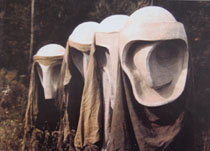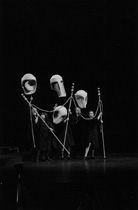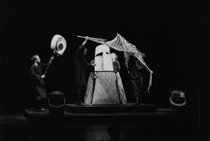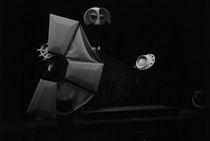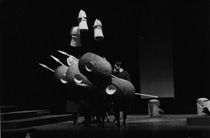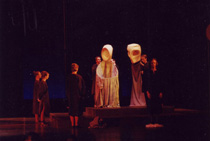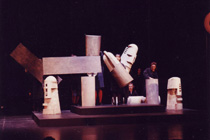 L'ENFANCE DU CHRIST, 1980
L'ENFANCE DU CHRIST, 1980
Musique : Hector Berlioz
Mise en scène : Felix Mirbt
Sculptures : Carolyn Davis, Felix Mirbt
Voici ci-dessous une sélection d'écrits de Felix Mirbt directement liés à la pièce L'Enfance du Christ ou en écho à son travail sur cette production, ainsi qu'un extrait de critique datant de la création en 1980.
L'ENFANCE DU CHRIST (1980 and 1997)
ORATORIO by Hector Berlioz
The oratorio is written in three parts, based on three biblical stories:
HEROD'S DREAM
King Herod reflects on the child, who will overthrow his power. From his soothsayers he learns that his throne will be preserved only if all the recently born children in his kingdom are put to death. And he gives orders for the massacre of the innocents.
THE FLIGHT TO EGYPT.
The shepherds gather at the stable to say goodbye to the Holy Family.
THE ARRIVAL AT SAIS.
After great hardships the Holy Family reaches the city of Sais. An Ishmalite, a carpenter like Joseph, invites them to stay and live with him and his household.
This is a huge work by Berlioz, for a 58 piece Symphony Orchestra, a male choir, a mixed choir, a children's choir and 8 soloists.
To carry THE VISUALS I used a manipulator/performer cast consisting of twelve performers.
"For the Guelph show, Felix Mirbt and Carolyn Davis have come up with some spectacular figures and these will be manipulated by six professional puppeteers who have worked with Mirbt before, and six young students from the Guelph area."
"One of the problems was that as a sculptor, Davis had to satisfy her muse; yet, what she was creating had at the same time to satisfy the needs of someone working in another medium. It was the combination of the two art forms that was the most challenging and which provided the ultimate satisfaction for both Mirbt and Davis."
"What a pity this production is being seen only in Guelph and Kitchener and is not being toured across Canada. This may well prove to be one of the most important musical-dramatic productions of the coming decade in Canada."
Jacob Siskind, Ottawa Citizen, 3.5.1980
L’ENFANCE DU CHRIST - August 16, 1992
For our rehearsals of Berlioz' L'Enfance du Christ I invented the term 'compound manipulatio': two or more performers had to create one character and it was one of our warm-up exercises to march the roman soldiers around the rehearsal hall. Pretty difficult fare for High-school students and non-militaristic "actors", you could not act it out, you just had to do it, get into it. Nicky Goldschmidt, our producer as well as conductor sort of tried to give me a hint by bringing someone in to help us march. It was shortly before the dress-rehearsal, that an elderly, white-haired gentleman, a member of the board, if I remember correctly, came in and talked to us.
He tried to assure us that his skill in army drill in no way indicated a militaristic or aggressive attitude on his part. And so he lined us up and explained to us the first and basic attitude of a new recruit: you are scared shitless. What do you do? You press the cheeks of your arse together and pull in your belly. And than we marched. We turned corners, stopped all together, learned to turn about, than grabbed our Roman Soldiers and did it all over again. It worked. It had sharpness to it and the Roman Soldiers became really soldiers, all within 45 minutes: a rather frightening result. Two thousand years of experience definitely helped Berlioz.
So I wanted to do it again during the Woyzeck - rehearsals for Edinburgh. After various unsuccessful tries to find a drill instructor I called the German Embassy and asked for the military attaché. I got his secretary and she took great pains to make it clear to me, that he would have no advice or even training to help me with, regarding the "past" times, because he never had been part of it, had been too young (nicht dabeigewesen!). He did eventually come with his "kumpel", who looked to me like the 6ft prototype of a German-Aryan-blond SS man. He was probably his bodyguard, and definitely "muss dabeigewesen sein": he "konnte Griffe kloppen" and knew German drill, which we ultimately did not use.
And both came various times and watched the rehearsals with fascination (together with Albrecht Roser). Later on I wanted to find army boots, real German WW2 army boots (this is really a different story) and , calling the Embassy again, got the "Unteroffizier vom Dienst", the guy on guard duty. I stuttered around on the phone, but than simply asked for "Knobelbecher"(Dice cups). He knew immediately what I was talking about, obviously delighted that we discussed it without having to explain any further. I still try to imagine the face of the RCMP officer listening in.
Pourquoi la marionnette me fascine-t-elle toujours autant ?
Ou : ( À lire avec une voix de stentor) L’objet TotÉmique
Je ne suis pas Freud pour être anti Jung, C.G. Jung enterre ses poupées. Je les déterre. Je les retire de terre.
La raison qui m’a emmené aux marionnettes n’est pas encore claire pour moi. J’ai toujours pensé que ça avait à voir avec leur mécanique fascinante. Je tire une ficelle en haut et quelque chose bouge en bas. J’imagine que c’est en partie vrai.
Mais je soupçonne aussi que c’est lié au sentiment sécurisant que j’ai, de pouvoir contrôler l’image. De pouvoir étudier un mouvement qu’on exécute lentement, avec recul. J’aime aussi dissocier le texte parlé du manipulateur. J’ai l’impression que le texte peut être retravaillé ainsi, aliéné à une autre couleur, à un autre point de vue.
Ces jours-ci, j’essaie de travailler avec des formes abstraites, des formes qui n’offrent pas une signification, une compréhension immédiate.
La fascination opère encore.
Vous m’avez toujours demandÉ pourquoi…
Je trouve que c’est un problème que
- Le spectateur s’identifie à l’acteur et l’acteur au personnage.
C’est qu’alors, le spectateur peut s’identifier uniquement au personnage et non au rôle symbolique lui-même.
L’objet (masque – marionnette) brise cette union et propose une image plutôt qu’une incarnation.
